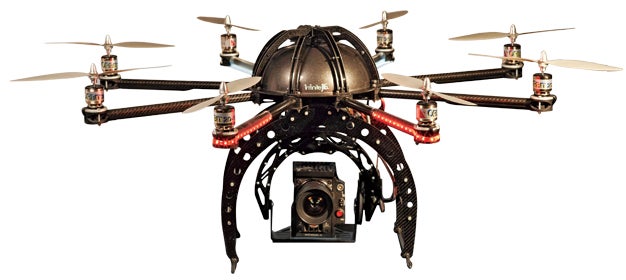Photography Drones: Robot Cameras Take to the Skies
These remote-controlled multi-rotor aircraft can capture amazing footage—and are fast becoming today’s must-have photo accessories

We may earn revenue from the products available on this page and participate in affiliate programs. Learn more ›

Brit Paul Bunyard made this image in Warwick, England, by sending a GoPro 3 200 feet into the air in a four-prop DJI Phantom drone. Paul Bunyard
If you’ve noticed a sudden proliferation of photos and video taken from above—but seemingly from far too low to have been shot from a plane—chances are that you’re looking at images shot from a drone. High-end units are being used in sports photography, real estate, law enforcement, and even major motion pictures. Drones are some of the most exciting new photographic tools in recent history. And flying these multi-rotor, radio-controlled aircraft is almost as thrilling as the images they can produce.
Why now? Recent advancements in flight controllers and aircraft stabilizers have made it possible for almost anyone to strap a decent camera into a drone, send it skyward for capture, and return it to earth in one piece (most of the time).
Also known as multi-rotors, unmanned aerial vehicles (UAV), quadcopters, and octocopters, these relatively affordable aircraft deliver photography that was—up until now—impossible at any price. They’re able to fly outdoors, even in slight wind, and sometimes in confined indoor spaces, too. Multi-rotors can legally operate at heights up to 400 feet, and range in price from $300 to up to $30,000.
Drones come in four-, six-, and eight-prop versions that can accept cameras ranging from compacts to high-end DSLRs. They’re powered by rechargeable batteries that provide between 6 and 15 minutes of flight time per charge, depending on the model and payload. Some are ready to fly out of the box, others require more at-home engineering.
Their technology starts with the propellers and motors, which produce minimal vibration for steady video capture. Most are operated by sophisticated radio-control (RC) consoles with joysticks for setting altitude, direction, and speed. The Parrot AR Drone 2.0 is controlled by iOS apps on iPhones and iPads. Most airborne multi-rotors “know” their location by communicating with six or more GPS satellites.
Yes, crashes happen. Many units, however, prevent or minimize damage by automatically returning to the site of liftoff when power drops or communication with the control console is compromised.

TIPS
Buyer Beware
Before investing in a multi-rotor, check with online user forums to learn of the experiences others have had with the units that interest you. This product category—especially the low end—is still in its infancy.
Try Flight Training
To learn to fly a multi-rotor before taking your valuable camera aloft, experiment with an inexpensive unit such as the Blade mQX ($119, street). There’s even optional flight simulation software for it.
THIS ARTICLE IS FROM THE JUNE ISSUE OF POPULAR PHOTOGRAPHY, ON NEWSSTANDS NOW!